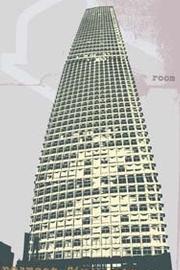There are now dedicated facade groups within companies, made up of individual specialists who can offer input on projects where their area of expertise is required. At Arup, the facades group includes structural engineers, architects and facade designers. Mikkel Kragh is among their number, and believes having these expert individuals is key to delivering the highest standard of work. "The nature of the project will determine which of the specialists you bring on board at different stages. A given specialist may have a limited involvement but that involvement is totally integral to the project." These specialisms are tested further when applied to the facade of a tower. "It's a completely different skill to facade engineering in conventional buildings," says Mott Macdonald's Steve Logan. "Tall buildings are a very different animal to low storey buildings. The interaction with facade engineers is very important and that's why you've started to see this specialisation." Logan says that the philosophy at Mott MacDonald is "not to sacrifice architecture on the alter of low energy" when it comes to tall buildings, but rather to exploit the opportunities the architecture presents to the engineer.
One issue that perhaps demonstrates most clearly the difference in the opportunities presented by tall buildings, and also the approach required, is the problem of shading. "You don't have the same options as you do for low rise," says Kragh. "External shading is the best way to provide solar shielding and it's not an option. That's where the set of possible solutions is different." With the amount of facade area per floor being so much higher, the emphasis has to be on cooling the building and control of the solar gains. This is where the first conflict arises: trying to control the solar gains on one hand and the quest for transparency and day lighting on the other. The two are totally in conflict. One option that Logan describes as "fraught with peril" in hot climates is the use of tinted glass. The glass can reach temperatures of up to 60°C, causing major comfort problems. "In prestige tall buildings, all the high flying managers have offices around the perimeter and their desks by the window. The bems will control the amount of cooling and as far as it's concerned it will think the room is comfortable at 22°C. The problem is that you've got a 60°C surface 2 m away, so the office occupant is going to be very uncomfortable."
Understanding the physics
Designing for different climatic conditions is a major part of facade engineering and there have been instances in the past where the same design approach has been taken for a project in a hot climate as was used in cooler circumstances. Kragh says: "We see attempts at copying certain architectural expressions in different climates and the physics just don't work. That's also where we get some business in helping to get it right."
It is this total understanding of the physics of the building that is central to the successful performance of the tall building facade. London is possibly the best example of where these physics can be at their most complex. The dilemma faced in the English capital is, with the sweltering summer just passed, should tall buildings be orientated for hot or cold climates?
With the requirement through Part L for the improvement in U-values, one tool being used to achieve this is low emissivity glass. In hot climates, the low emissivity coating is employed on the outer surface to reduce the amount of heat coming into the building from the sun, whereas in a cold climate, it would be used on the inner surface where it would prevent heat from leaving the building through the glass. In London, one would expect the building to be set up for cold climate conditions, but the weather in recent months would suggest that this causes problems, as Logan explains: "In cold climates, you allow the glass to get warm from the heat given off from surfaces inside the building.
Tall buildings are a very different animal to low storey buildings. The interaction with facade engineers is very important.
The low emissivity coating means the warm glass doesn't efficiently re-emit that heat, which is great if it's 2°C outside. But in London we've had a seriously warm summer and this is counteractive." Tall buildings that have big foot plates and high pc loads will have a lot of heat inside the building, and so the debate commences over whether to have hot or cold climate orientation. "It takes some analysis to decide whether to specify low emissivity on surface three to keep heat in or on surface two to keep it out," says Logan.
Source
Building Sustainable Design























No comments yet